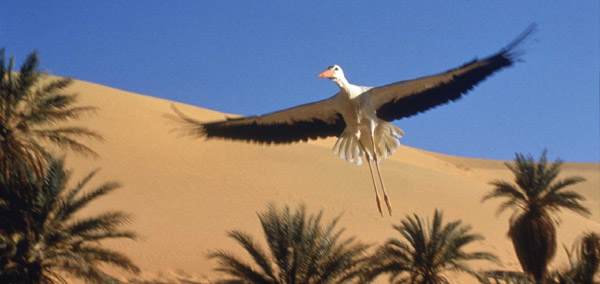

|
Winged Migration
10 out of 10 |
 |
|
A Life-Changing Bird Experience Giving up 5 years of his life on a project about which it is almost insuting to term a "documentary", master film-maker, Jacques Perrin has produced one of the most truly awe inspiring films of all time. Ironically introduced and closed with a very camera-hungry robin, a bird that does not migrate, "Winged Migration" is not a "life-cyle" science flick, but an entire experience, a story where the birds are the stars and man is but a background piece of nature.. Other than a handful of obvious transition shots as birds are silhouetted against a giant globe, no special effects were used. Instead, amongst other things, Perrin actually hand-reared some otherwise wild birds and introduced them to various engine sounds so that, to them, mankind was just a harmless other species that happened to fly with them. With the help of balloons, towers and a microlight with a 360 degree view, the results are amazing. It is as if you are flying iun formation with birds, so close you could reach out and touch them. In shots are of breathtaking beauty, various birds fly over the Great Wall of China in the morning mist, up the Seine towards the Eiffel Tower in Paris, past the World Trade Centre against a crystal blue sky, over a huge observatory and ancient castle ruins, away from a collapsing iceberg the size of an office block and against the monstrous backdrop of the Himalayas. A prime reason for the sheer quality. is also the extent of the work emcompassed by Perrin. The 99minutes of film includes the best from over 15,000hours of flight time. Despite having only a fraction of the budget for even a cheap Hollywood horror flick, Jacques Perrin assembled a production crew that ressembled a small army with than 450 people in five film crews, including 17 pilots and 14 cinematographers working in 40 countries such as Peru, China, India, Senegal, France, Vietnam, United States and Iceland across every continent, including Antarctica. The locations are as close as to being a travelog of the entire planet as is possible whilst the colours are incredible too with brilliant white storks above the Saharan sands, geese above the dappled Autumn shades and others above a river, its bed as red as blood and below the sharp light of an eclipse of the moon. Apart from rare odd note, such as pointing out that the Arctic Tern flies 12,500 miles each way a year, "Winged Migration" has as little narrative as possible with Perrin using imagery rather than speech to make comment. Dying in the toxic sludge of an east European industrial wasteland, blown out the sky by french hunters or facing a line of agricultural tractors that closely ressemble the four horsemen of the apocalypse, for instance, it's usuallly the avians who come off worse. The one exception, however, is a cheeky parrot, resplendent in his shock of primary colours, incredibly, works out how to open his cage and escape as he is being taken away down the Amazon on a tramp steamer to captivity. The events that befall the birds are diverse, landing on a French warship in the midst of a storm at sea, fleeing from a stampede of wild horses in the mid-west of the USA and swans flying against a bracing blizzard. There's tragedy with a doomed seabird with a broken wing struggling to escape the crabs who close in for a tasty treat, the greedy and evil cuckoo chick pushing the eggs of its sibblings over the nest edge to oblivion and the two penguiins fighting off a predator without seeing its henchman, sneaking in behind to snatch away their only offspring... But there's beauty too with a whole range of chicks surviving and the water ballet of Clarke's geese upon the lakes of Oregon. And throughout, a Canadian goose that a little boy saves from a trap at the start flying valiantly through.every disaster, still with netting around his foot. From the Kingfisher to the Andean Condor,.from
albatross to owl, "Winged Migration" honours the French motion
picture industry, the oldest in the world, by standing as one of the
truly great achiements of the industry's history.
Film Critic: Robert L Thompsett
|
|